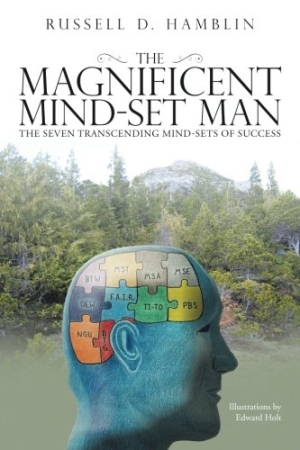The Magnificent Mind-Set Man
The Seven Transcending Mind-Sets of Success
Self-help, science fiction, and Christian themes weave together among this novel’s breathtaking settings.
Russell D. Hamblin’s The Magnificent Mind-Set Man explores faith and self-reflection through the lens of an everyman who wants to create a better life.
Roger Hunt is an environmental geologist who battled gambling addiction and ended up with a fairly normal life: a steady job, a wife and kids, and a casual Christian faith. During a geological survey trip to Bokan Mountain, however, he has experiences that are far outside his norm. Roger finds the memoirs of a reclusive and eccentric man named Billy Haynes; paired with futuristic technology and out-of-body experiences, they lead Roger to a new way of thinking about God and his life.
Roger’s story is well-paced; he gradually finds more writings and artifacts left by Billy. Each piece of writing includes a key card and metallic figurine, and is accompanied by an astral-projection-style dream experience that helps Roger understand the lessons Billy wants to impart. The technology for the key cards is described but never fully elaborated on, and the usefulness of the figurines is never explained. Concepts are frequently referred to by abbreviations, and as more and more abbreviations are added, it can be difficult to remember what they mean.
During Roger’s dreams he is led by a figure, the “Magnificent Mind-Set Man” of the book’s title, whose origin and constitution also remain a mystery throughout the book. Moral and psychological lessons are conveyed through a specifically Christian lens, and could be offensive to those outside of the religion. Roger’s discovery of the key cards, dream experiences, and readings follow a formulaic arrangement, resulting in a story that becomes predictable.
Characters’ backgrounds intertwine with the narrative; stories about their children, as well as problems like addiction, help make them relatable. Dialogue and internal monologue are believable, though overtly religious segments sound contrived. Billy has extraordinary abilities that are not made clear, and his motivations and actions become implausible without further explanation.
The book starts in the present day, but most of it takes place in the past; it returns to the present at the very end. Considering the impact of Billy’s revelations, the huge, unaccounted-for gap of time between the past and present is confusing and at odds with many aspects of the plot.
Billy’s memoirs function as a kind of book-within-a-book, and the novel comes to read like a Christian-inspired self-help book as a result. Roger’s perspective helps to emotionally connect to the lessons, but his apparent lack of application contradicts the book’s themes of self-assessment and action.The main story line is not wholly resolved by the end, and several questions about the characters, Roger’s experiences, and Billy’s abilities are left open.
The settings of the novel, particularly descriptions of Bokan Mountain, are deep and beautifully rendered. It is easy to imagine the breathtaking vistas and cold, damp cave systems that are described in detail. Roger’s spiritual and emotional attachments to the places, objects, and animals of Bokan become an important part of his narrative, though they seem to be easily left behind when he leaves the mountain.
The Magnificent Mind-Set Man is a self-help story with science fiction elements that promotes faith in God and self-mastery as the keys to a successful and happy life.
Reviewed by
Delia Stanley
Disclosure: This article is not an endorsement, but a review. The publisher of this book provided free copies of the book and paid a small fee to have their book reviewed by a professional reviewer. Foreword Reviews and Clarion Reviews make no guarantee that the publisher will receive a positive review. Foreword Magazine, Inc. is disclosing this in accordance with the Federal Trade Commission’s 16 CFR, Part 255.

